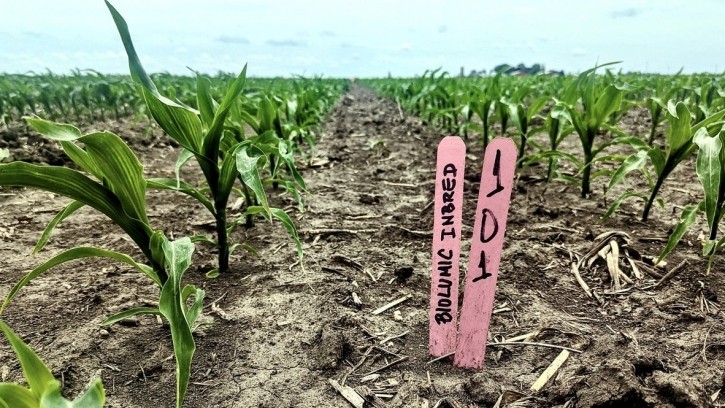BioLumic sheds light on its UV tech as it partners with seed majors

New Zealand-based BioLumic uses ultraviolet (UV) light to enhance plant growth, productivity, and resilience.
It claims it is the world’s only company treating seeds with light to activate genetic expression for new crop traits. By using ultraviolet (UV) light signalling to rapidly activate natural genetic expression in plants, it says it can improve yield, quality, and plant defence traits without requiring genetic modification or chemical additives. This makes for an environmentally sustainable and scalable solution not constrained by regulatory barriers or consumer concerns.
BioLumic’s technology is being commercialised for inbred and hybrid corn cultivars, with plans under way for light-treated seeds to be available to farmers for the 2025 planting season.
US field corn production is dominated by vigorous, high-yielding hybrid cultivars bred from crossing genetically pure inbred seed lines to target specific traits. However, problems experienced with inbreeding depression – including reduced germination, poor seedling emergence and vigour, increased susceptibility to environmental stressors and nutrient deficiency – often result in reduced yields and poor hybrid seed quality during the seed production process.
BioLumic’s light treatments for inbred seed are tailored to solve the problems associated with inbreeding depression. In 2023 trials, treated inbred corn lines with the stand establishment and yield trait package demonstrated a more than 7.3% yield gain without any changes compared to the grower’s standard practice – and the company is targeting double-digit yield gains this year. These substantial improvements in inbred uniformity and yield were driven by enhanced early-season germination and increased seedling vigour, including an average 16% advantage in root biomass.
Multiple traits also targeted
BioLumic’s Genetic Expression Traits can also be stacked together as trait packages to target multiple traits, such as improved stand establishment, yield, and composition (e.g. lipid content).
“Through our partnership with BioLumic, we are integrating this unique technology into our hybrid and inbred corn lines, evaluating BioLumic’s trait performance on some of our most promising germplasm this season,” said Marc Neuman, director of sales and product development at Breeder Direct. “Our mission is to deliver elite genetics that give our seed company clients improved margin opportunity. BioLumic’s ability to improve the yield potential of germplasm that is already outstanding creates a big opportunity for us and independent seed companies.”
Thanks to the new breakthrough, BioLumic believes it is one step closer to offering an alternative to gene editing and GMO approaches to new trait development in seed breeding.
We asked BioLumic CEO Steve Sibulkin more.
ATN: With any new technology, regulatory hurdles and public acceptance are still significant considerations. Will light-activated systems face scrutiny similar to that of GMOs, particularly concerning their long-term effects and safety?
SS: BioLumic is a science-driven, farmer-first organisation. We advocate for solutions that are safe, effective, and beneficial for farmers, particularly when they contribute to positive environmental and nutritional outcomes. Take biotech crops like Golden Rice, for instance, which can combat vitamin A deficiency in many developing countries for reducing the risk of blindness, and lower child mortality rates. I'm encouraged by more nuanced thinking in cisgenic editing, which create an easier pathway when changes in a plant’s DNA is similar to what could be achieved with traditional crossbreeding, albeit at a much faster pace.
That said, we’re also pragmatists. Bringing a GMO trait to market can take over a decade and cost upwards of $150 million, with gene editing being slightly faster, so there remains a large gap in the market for seed trait improvements that can deliver immediate productivity boosts to farmers and more nutritious foods to consumers. In today's rapidly changing environment, the agricultural sector cannot just rely on solutions with these lengthier timelines.
That’s a key reason BioLumic's Genetic Expression Crop Traits are important. They don’t alter the genetic makeup of plants but instead activate the existing genetic potential within seeds. Our UV Light Signal gives us head start and precision to deliver these desired traits in crops in plant yield, health and composition, all while accelerating the time to market.
Plus, our Genetic Expression Seed Traits are also designed to be stacked with other innovations, providing even greater flexibility and value to farmers.
ATN: What other initial barriers need to be addressed for light-activated genetic trait expression to take on gene editing and GMO methods in seed breeding?
SS: Rather than seeing these technologies as competitors, we view them as complementary.
On our end, BioLumic's novel trait technology is focused on working with leading agricultural, food, and environmental organizations to demonstrate the power and adaptability of our approach to key industry challenges.
For example, we’re applying our technology to rice cultivation, enabling young rice plants to outcompete weeds without the need for flooding, which saves water, reduces methane emissions, and lowers labor inefficiencies. This could be a game-changer for dry direct seeding rice (DDSR) cultivation, significantly improving and de-risking global rice production.
Additionally, we’re working on enhancing the nutritional content of forage grasses, making them more metabolically efficient for livestock and reducing enteric fermentation—a major source of agricultural methane emissions.

In both cases, finding the right commercial and non-commercial partners has been crucial.
This is also true of our partnership with Gro Alliance LLC, a leading corn and soybean seed production company. That collaboration has opened up a channel to understand seed company priorities and challenges and provided a pathway to distribute our traits widely and efficiently across the industry.
One of the primary challenges has been building up a robust data stack to inform and validate our technology. Over the past few years, we've focused intensely on expanding our platform's modeling capabilities, integrating millions of data points from field and lab trials. This work has allowed us to connect the dots between genetic markers and light-signaling trait activation across more than 12 key agricultural crops.
That work, and ongoing research, also focuses on the underpinning mechanistic understanding of light signaling, including our ability to pass on cross-generational traits to hybrid plants, a massive amplifier for our technology platform.
Another challenge has been raising awareness and educating stakeholders about the transformational potential of this technology. Transparency has been key; we’ve made it a priority to educate our partners how BioLumic’s technology works and the value it offers to global agriculture.
ATN: Is the technical complexity of integrating light-activated systems into existing agricultural practices a barrier?
SS: On the contrary, it’s an area where we see tremendous advantage. We’ve deliberately focused on making our seed traits easy to deploy and distribute through our enterprise partners. For instance, in corn and soybeans, we’re introducing a next-generation treatment system in a seed conditioning facility for the 2025 crop season. This system is 80% more energy-efficient, modular, and incorporates our expanding catalogue of light signal recipes along with new monitoring and optimisation tools, significantly increasing our production capacity.
Moreover, our recent advancements in cross-generational trait pass-through are a game-changer. By passing beneficial traits from treated parent plants to untreated progeny while maintaining crop yield, health, and quality gains, we’ve created a 100x more scalable and cost-effective solution that can benefit both large and smallholder farmers.
Our partnership with Gro-Alliance exemplifies this. BioLumic’s stackable traits offer a distinct competitive edge to their seed company partners, while enabling us to treat the most impactful seed varieties for farmers.
ATN: Surely fewer people are experts in it? Is there a significant knowledge barrier regarding the application of UV light signaling in agriculture?
SS: Yes and no. The scientific foundations of photobiology and photomorphogenesis are well established and recognized in plant science. These disciplines, along with genetics, molecular biology, and light technology innovation, form the basis of our work at BioLumic. Our trials and data are executed using best practices and validated by third parties, so when we present our findings, they are well-received by those familiar with these fields.
The incredible ability of plants to adapt to stimuli is undisputed, and our unique approach to light signaling is simply an extension of this natural process. With Dr. Jason Wargent, a world-leading plant photobiologist, leading our scientific efforts, we’ve built unparalleled expertise in this area.
I estimate that there are now 100 times more people who are assessing, testing, or even contributing to Genetic Expression Seed Traits and BioLumic’s approach than there were just 24 months ago. This trend is expected to continue.


















